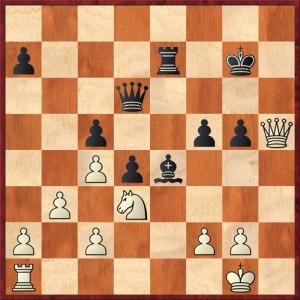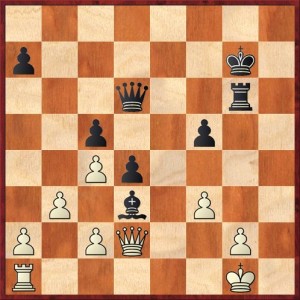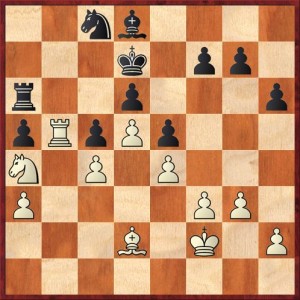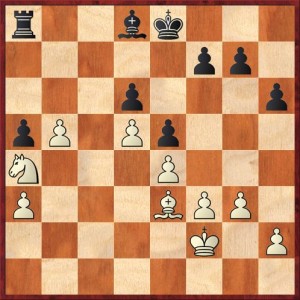It seems as if I’ve spent the whole last month writing about the World Cup. But now September is here, and I have a tournament of my own to write about — the CalChess Labor Day Championships. I’m playing in the expert section, and rather amusingly I’m the highest-rated player in the section even though my current rating is 2122. (At least, I’m the highest-rated in the three-day schedule. There could be somebody in the two-day schedule who is higher, I just don’t know.) The reason that’s amusing is that the section is nominally for people rated between 2000 and 2199. But in fact, there were two players rated 2100-2199, about six players rated 2000-2099, and about ten players rated below 2000.
Of course, this is not all that unusual — a lot of people like to play up in a higher section, even though there are substantial inducements for playing in “your own.” In this case, first prize in the under-2200 section is $800, compared to $300 for the top under-2300 player in the master section. Nevertheless, the 2100 players seem to have opted almost unanimously for the higher section.
So I’m playing the role of Levon Aronian in the expert section, and hopefully I’ll do better than he did in the World Cup.
Both of my games yesterday were very interesting, and I’m not completely sure in either one of them whether I should have won, drawn, or lost. I drew the first one and won the second. Here are the crucial positions from each game.
FEN: 8/p3r1k1/3q4/2p2ppQ/2Ppb3/1P1N4/P1P2PP1/R5K1 b – – 0 29
Here I’ve sacrificed a pawn for kingside pressure. It’s just before the time control, and my opponent (Gabriel Bick) has just moved his queen to h5, inquiring how I am going to defend all of my loose pawns. I had been expecting this move, and I hit him with the surprising 29. … Re6! Of course the point is that taking the pawn would lose: after 30. Qxg5+ Rg6 the counterattack is too strong.
However, my opponent defended well. With less than a minute left on his clock, he played the correct 30. f3! I was still under the impression that I was just winning, and I played 30. … Bxd3. (Perhaps some readers can tell me whether there is a better move.) Now we both had plenty of time to think, and he played 31. Qxg5+ Rg6 32. Qd2!
FEN: 8/p5k1/3q2r1/2p2p2/2Pp4/1P1b1P2/P1PQ2P1/R5K1 b – – 0 32
How inconvenient! My bishop’s life is still forfeit. I racked my brains for 17 minutes here trying to come up with a win, and I couldn’t do it. Again I’ll leave it to my readers as a challenge: Is Black winning here? The move I finally played was 32. … Be4. My thinking was as follows: the problem for Black is that in many lines after … Rh6 White’s king will escape to f2. The queen check on h2 is only a check, not a mate. So to really get mating threats, I really need a pawn on e3 to take away the king’s flight square. Also, if we get to an endgame I thought that the protected passed pawn on e3 should be compensation for White’s extra pawn.
What I didn’t really count on was the fact that after 32. … Be4 33. fe fe 34. Rf1 e3 35. Qe2 Qg3 36. Qf3 Black’s king is pretty darned exposed, too. So I had to trade queens here and go into the aforementioned endgame after 36. … Qxf3 37. Rxf3. And now I basically had to grovel for a draw, which I succeeded in getting, but all in all it was a somewhat disappointing conclusion to a game that I thought I was going to win. However, looking at it the morning after (without a computer) I don’t see any forced wins. I think you just have to give my opponent credit for a well-played defense.
In round two I got my “karma points” back and then some. This was a game where I thought my experience of watching the World Cup over the last month paid some dividends. The game lasted 88 moves and it was the last game in the round to finish, but after watching the 169-move games and 153-move games at the World Cup, 88 moves seemed like a holiday by comparison.
Here’s the crucial position. I’m White against Chaijijay Myagmarsuren.
FEN: 2nb4/3k1pp1/r2p3p/pRpPp3/N1P1P3/P4PP1/3B1K1P/8 w – – 0 42
This was very similar to my game with Agata Bykovtsev that I wrote about in July (my most recent tournament game as White). As in that game, I got a slight positional pull and, most importantly, I was able to completely eliminate any chance of counterplay for my opponent. The question, again, is whether White will be able to use his slow and steady pressure to break through.
In this position a funny thing happened. About thirty seconds after my opponent played the move 41. … Ra6, I saw him give a little start of surprise. Now I had already been looking at the possibility of a pseudo-sacrifice with 42. Rxc5, with the idea that after 42. … dc 43. Nxc5+ Kc7 44. Nxa6+ White’s knight manages to escape after either 44. … Kb7 45. Nc5+ or 44. … Kb6 45. Nb8. But there are other possibilities to consider, too. However, my opponent’s reaction convinced me that it had not been his intention to allow 42. Rxc5, i.e., it was not a trap. And this made me perhaps a little bit too eager to play it.
Well, I did think about it for about 10 minutes, but finally I played 42. Rxc5. And immediately regretted it, because I suddenly realized he could trap my rook with 42. … Na7! So it was a trap after all! Maybe not an intentional one, but a trap all the same.
But it turned out that I had the last laugh. After the forced 43. Be3 Ke8 44. Rb5! Nxb5 45. cb Ra8, we get to a position where I literally do not know the correct evaluation. Am I winning? Losing? Drawing? You tell me!
FEN: r2bk3/5pp1/3p3p/pP1Pp3/N3P3/P3BPP1/5K1P/8 w – – 0 46
Well, I really do not think that Black should be losing here. But look what happened! He played what I thought was the most natural plan, 46. Ke2 Kd7 47. Kd3 Kc7 with the idea of bringing his king to the queenside and then activating his rook. But after 48. Nb2! Kb7 49. Nc4 Be7 50. a4! we get to a position where Black is almost certainly lost! He can’t defend both the d-pawn and the a-pawn. After a time scramble where both players undoubtedly made lots of mistakes, I was able to secure the victory.
Isn’t it funny how bad moves sometimes turn into good ones? Black’s 41. … Ra6 provoked my perhaps unsound exchange sac. But the exchange sac unbalanced the position to the point where my opponent could not handle the complications. Maybe if I hadn’t sacrificed the exchange, he would have been able to hold on and draw.
By the way, I think that the correct idea for Black, either in the diagrammed position or one move later, would be to play … Rb8 in order to force White to commit his pawn to b6. But I’ll let you figure it out. It’s time to put yesterday behind me and focus on today’s two games.







{ 3 comments… read them below or add one }
Very cool save. “Playing for three results.”
I saw the name and immediately wondered whether your opponent is related to L. Myagmarsuren of _My 60 Memorable Games_ fame.
I knew the name was familiar, but I didn’t know why! Thanks for jogging my memory. If I see him today, I’ll ask. (Whether he’s related or not, I’ll bet he gets that question a lot.)
I could not but marvel at how beautiful white’s position was on the table next to mine (which I did when I was tired of lamenting the sorry state of my own KID, which I generally hold beloved). It seems that you cannot play the wedge (or is it Czech) Benoni formation without being super familiar with its nuances, or you will just get crushed. And then, when I saw this position there, I thought it was an intentional exchange sac, and was even more amazed. I did recall your other game posted here though.
As always, excellent endgames by Dr. Mackenzie.
{ 2 trackbacks }